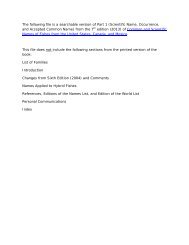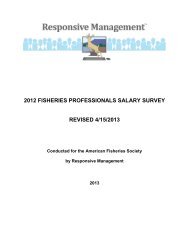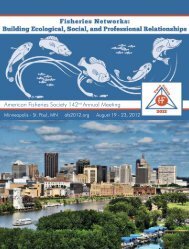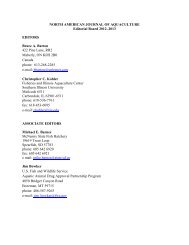Conservation Status of Crayfish Species Paddlefish Conservation ...
Conservation Status of Crayfish Species Paddlefish Conservation ...
Conservation Status of Crayfish Species Paddlefish Conservation ...
You also want an ePaper? Increase the reach of your titles
YUMPU automatically turns print PDFs into web optimized ePapers that Google loves.
• Many agricultural practices have<br />
disproportionately negative impacts on<br />
aquatic ecosystems relative to others.<br />
For example, some crops (e.g., corn) are<br />
nitrogen intensive and require the application<br />
<strong>of</strong> high concentrations <strong>of</strong> nitrogenbased<br />
fertilizer that can lead to hypoxia<br />
and perhaps nitrogen toxicity to fishes.<br />
Feedlots and other mass livestock operations<br />
generate tremendous burdens on<br />
aquatic systems by increasing eutrophication<br />
<strong>of</strong> waterways and perhaps leading<br />
to blooms <strong>of</strong> toxic microorganisms (e.g.,<br />
red tides in estuaries). crops that are bioengineered<br />
to produce BT insecticide may<br />
contain residue that is harmful to aquatic<br />
insects within streams and thereby other<br />
organisms that require these insects as a<br />
food supply (i.e., fish). Subsidies provided<br />
to these and other high-risk types <strong>of</strong><br />
agriculture by the 2007 Farm Bill need<br />
to have strict associated safeguards to<br />
ensure the integrity <strong>of</strong> aquatic ecosystems<br />
within associated watersheds.<br />
• When implementing the various Farm Bill<br />
programs, NRcS must give equal status<br />
to soil and water conservation issues in<br />
their decision-making. State-<strong>of</strong>-the-art<br />
BMps must be adopted to minimize the<br />
impact <strong>of</strong> farming, ranching, and forestry<br />
on adjacent and downstream water<br />
resources. In addition to nutrient loading,<br />
soil erosion and resulting sedimentation<br />
<strong>of</strong> streams and associated backwaters<br />
continues to be an alarming problem.<br />
ultimately, increased sedimentation<br />
caused by poor soil conservation leads<br />
to choked waterways and increased<br />
dredging. dredging in navigable rivers<br />
is expensive and potentially damaging<br />
to main-channel communities in<br />
large rivers. BMps to conserve soil and<br />
minimize degradation <strong>of</strong> stream habitat<br />
include but are not limited to:<br />
o Maintain vegetative buffer strips, especially<br />
shade trees, adjacent to waterways.<br />
o eliminate dams, avoid stream<br />
channelization, and discourage<br />
removal <strong>of</strong> woody debris.<br />
o eliminate, when possible, direct<br />
access <strong>of</strong> livestock to waterbodies.<br />
o provide controls for run-<strong>of</strong>f associated<br />
with concentrated animal feeding<br />
and other livestock operations.<br />
o protect headwater streams and wetlands,<br />
which many times contain sensitive<br />
and rare aquatic species and are <strong>of</strong>ten<br />
lost to impoundments or drainage; loss<br />
<strong>of</strong> wetlands and small streams may<br />
have far-reaching effects on food web<br />
interactions and habitat integrity in<br />
downstream reaches. Also, headwater<br />
streams are important for absorbing<br />
nitrogen (peterson et al. 2001).<br />
• Most states have developed plans<br />
for the conservation <strong>of</strong> wildlife and<br />
fish. In developing and implementing<br />
Farm Bill programs, these plans<br />
should be used for guidance.<br />
• unobligated or surplus Farm Bill programmatic<br />
funds should be reserved for fish<br />
and wildlife conservation and reallocated<br />
back to states in a competitive fashion.<br />
• use partnerships <strong>of</strong> like-minded<br />
organizations and initiatives such<br />
as the National Fish Habitat Action<br />
plan (AFWA 2006) and the American<br />
land conservancy when participating<br />
in Farm Bill policy development.<br />
clearly, the uSdA’s 2007 proposal is<br />
taking steps in the right direction. However,<br />
many issues including those outlined in<br />
the points above need to be addressed to<br />
balance terrestrial-based agriculture with<br />
sustenance <strong>of</strong> aquatic resources in the<br />
united States. It is important that members<br />
<strong>of</strong> the fisheries and aquaculture community<br />
make their scientific views known<br />
to the crafters <strong>of</strong> the next Farm Bill and<br />
participate fully in the shaping the future <strong>of</strong><br />
the nation’s natural resources. The aquatic<br />
environment and the fisheries resources<br />
dependent on it are vitally affected by<br />
Farm Bill provisions and should be fully<br />
considered when debating the future <strong>of</strong><br />
agriculture in the united States and the role<br />
<strong>of</strong> the federal government in that future.<br />
ACkNowLedgmeNtS:<br />
Members <strong>of</strong> the Farm Bill Advisory<br />
committee were phaedra Budy, david<br />
Bunnell, Scott Hale, craig paukert, and<br />
Russell Wright. The committee represented<br />
a broad geographical range as well as a<br />
cross-section <strong>of</strong> federal, state, and academic<br />
expertise in fisheries. The committee thanks<br />
Rob colombo, Robert Hughes, chris Kohler,<br />
paul pajak, Quinton phelps, Gus Rassam,<br />
and Matt Whiles for their helpful input.<br />
reFereNCeS<br />
AFwA (Association <strong>of</strong> Fish and wildlife<br />
Agencies). 2006. National Fish Habitat<br />
Action plan. AFWA, Washington d.c.<br />
berkland, m.w., and C.A. rewa. 2005.<br />
environmental quality incentives program<br />
contributions to fish and wildlife conservation.<br />
Fish and wildlife benefits <strong>of</strong><br />
Farm Bill programs: 2000-2005 update.<br />
pages 171-184 in The Wildlife Society<br />
Technical Review 05-2, Bethesda, Md.<br />
gray, r. L., and b. m. teels. 2006. Wildlife<br />
and fish conservation through the Farm<br />
Bill. Wildlife Society Bulletin 34(4):906-913.<br />
Hughes, r. m., L. wang, and P. w.<br />
Seelbach (editors). 2006. landscape influences<br />
on stream habitat and biological<br />
assemblages. American Fisheries Society,<br />
Symposium 48, Bethesda, Maryland.<br />
illinois Corn growers Association. 2007. corn<br />
growers step up to plant largest crop in six<br />
decades. press release. Illinois corn Growers<br />
Association, Bloomington. Available at:<br />
www.ilcorn.org/news/html/6-29-07.html<br />
Naiman, r.J., and m.g. turner. 2000.<br />
A future perspective on North<br />
America’s freshwater ecosystems.<br />
ecological Applications 10:958-970.<br />
Pajak, P., r. e. wehnes, L. gates, g. Siegwarth,<br />
J. Lyons, J. m. Pitlo, r. S. Holland, d. P.<br />
roseboom, and L. Zuckerman. 1994.<br />
Agricultural land-use and reauthorization <strong>of</strong><br />
the 1990 Farm Bill. Fisheries 19(12):22-27.<br />
Pajak, P. 2000. Sustainability, ecosystem<br />
management, and indicators: thinking<br />
globally and acting locally in the<br />
21st century. Fisheries 25(12):16-29.<br />
Peterson, b. J., and 14 co-authors. 2001.<br />
control <strong>of</strong> nitrogen export from watersheds<br />
by headwater streams. Science 292:86-90.<br />
roy, A. H., m. C. Freeman, b. J. Freeman, S.J.<br />
wenger, w. e. ensign, and J. L. meyer.<br />
2005. Investigating hydrologic alterations<br />
as a mechanism <strong>of</strong> fish assemblage shifts<br />
in urbanizing streams. Journal <strong>of</strong> the North<br />
American Benthological Society 24:656-678.<br />
Scott, d., J. Harvey, r. Alexander, and g.<br />
Schwarz. 2007. dominance <strong>of</strong> organic<br />
nitrogen from headwater streams to large<br />
rivers across the conterminous united<br />
States. Global Biogeochemical cycles 21:1.<br />
Stoddard, J. L., d. v. Peck, S. g. Paulsen, J.<br />
van Sickle, C. P. Hawkins, A. t. Herlihy,<br />
r. m. Hughes, P. r. kaufmann, d. P.<br />
Larsen, g. Lomnicky, A. r. olsen, S.<br />
A. Peterson, P. L. ringold, and t. r.<br />
whittier. 2005. An ecological assessment<br />
<strong>of</strong> western streams and rivers.<br />
epA 620/R-05/005, u.S. environmental<br />
protection Agency, Washington, dc.<br />
thomas, d. L., P. Pajak, b. mcguire, C.<br />
williams, S. Filipek, and r. m. Hughes.<br />
2001. Farm Bill 2002: a discussion <strong>of</strong> the<br />
conservation aspects <strong>of</strong> the Farm Bill from a<br />
fisheries perspective. Fisheries 26(11):36-38.<br />
USePA (U.S. environmental Protection<br />
Agency). 2005. Handbook for developing<br />
watershed plans to restore and protect our<br />
waters. epA 841-B-05-005, Washington, d.c.<br />
_____. 2006. Wadeable streams assessment: a<br />
collaborative survey <strong>of</strong> the nation’s streams.<br />
epA 841-B-06-002, Washington, dc.<br />
vanni, m. J., k. k. Arend, m. t. bremigan,<br />
d. b. bunnell, J. e. garvey, m. J.<br />
gonzalez, w. H. renwick, P. A.<br />
Soranno, and r. A. Stein. 2005. linking<br />
landscapes and food webs: effects <strong>of</strong><br />
omnivorous fish and watersheds on reservoir<br />
ecosystems. Bioscience 55:155-167.<br />
404 Fisheries • vol 32 no 8 • august 2007 • www.fisheries.org







